|
Introduction
We've been waiting for the ATi Radeon 8500 to appear for quite some time.
NVIDIA have had this class of graphics card to itself since the GeForce3
was released. 3dfx are no more and Matrox don't make gaming cards now
so NVIDIA have had the performance gaming sector to themselves.
ATi announced the R8500 to the world on the 14th of August to much fanfare.
It was to ship at 250Mhz and cost a recommended $399. At the time, ATi
were making bold claims for their new hardware.
"The RADEON 8500 clearly positions ATI as the technology and performance
leader. Enthusiasts will find an unequalled visual experience in the RADEON
8500," said Rick Bergman, Senior Vice President & General Manager, Desktop
Marketing, ATI Technologies Inc. "With the RADEON 8500 GPU (graphics processing
unit), the industry moves a quantum step forward, towards full visual
reality on the PC and Macintosh platforms."
Grand claims indeed for their new baby. Fast forward to 9th October, a
little later than the September launch date and ATi announce that cards
are ready. By this time we knew that core clock had increased to 275Mhz
giving parity with the memory clock and that price had dropped a whopping
$100 to $299. The card was Windows XP ready complete with XP drivers and
would ship on the 25th of that month.
Here I am a month later with the review and what a month it's been. We've
had the card for a little while now in the labs and for a little while
we held off on a review because of one thing, the drivers. A lot had been
said recently in the technology press about ATi's drivers. Developers
like John Carmack and Derek Smart have given their views on ATi's drivers,
driver writers and some of the things the driver does to improve performance
in certain applications like Quake 3 and 3DMark 2001.
For a little while with us, the drivers on our testing platform, the one
ATi made much fanfare about on October the 9th, Windows XP weren't in
that good shape. We stuggled with performance and while we have no qualms
about giving a bad review where a bad review is deserved, we had faith
in the hardware. The R8500 is a very nice piece of technology and like
all commodity PC hardware, needs drivers for it to function properly.
On November 14th ATi released a driver we were happy to use in testing
and base a review around. So while our review is a little later than some
others, it's a review we are happy to release. We'll ignore the furore
around the way the driver achieves performance in some applications. Everyone
has their views, we have ours but were not here to disect all that. We
hope you just want to know how the card performs, what the visual quality
is like, does it run your games well etc.
The Technology
So with all that out the way, lets take a look at what makes the tech
behind the 8500. For a start it's the first ATi graphics processor to
be manufactured on a 0.15 micron process. Previous Radeons were all 0.18
micron parts so the new R200 core runs faster and cooler. Packing in around
60 million transistors, 3 million more than the GeForce 3 which itself
is more complex than the Pentium 4 processor in terms of transistor count
and we have a hefty piece of silicon.
ATi have packed onto that wafer an array of technologies they hope will
give it the performance to beat the GeForce 3. First off we have the Charisma
Engine II. Following on from the original found on the Radeon, the Charisma
Engine is the name ATi has given to the Transform and Lighting (T&L)
engine.
The T&L engine works in tandem with their SMARTSHADER tech which
provides the vertex and pixel shader capability on the card and allows
it to implement the DirectX 8.1 specification in full. OpenGL 1.3 is also
supported.
Pixel Tapestry II is the R200's rendering engine, the heart of the new
chip. It gives us 4 rendering pipelines each capable of processing 6 textures
in a single rendering pass. This gives the R200 2.2GTexels/sec fillrate
and with a 128-bit DDR interface to 64Mb of memory at 275Mhz it has access
to 8.8Gb/sec of memory bandwidth eclipsing the 7.36Gb/sec provided by
the GeForce3.
To help optimise that memory bandwidth we have HyperZ II. HyperZ first
appeared on the original Radeon. HyperZ II gives an effective 25% increase
in memory bandwidth by being able to clear the Z buffer very quickly,
using compression of the Z buffer on the fly and by being able to discard
pixels before rendering.
Added to all this is SMOOTHVISION, ATi's method of full scene anti-aliasing
and effects like motion blur and depth of field. Then we have TRUFORM
that smooths out the edges of models in 3D games and applications. It
requires developer support to implement.
Finally we have HYDRAVISION, ATi's dual head implementation like NVIDIA's
TwinView and the original consumer implementation shown to us by Matrox.
It does dual DVI, combinations of panel, CRT and TV and supports UXGA
panels at up to 1600x1200 resolution.
Card Installation and Driver
I wont hide the fact that I've never had as much trouble making a graphics
card work. It took me 6hrs in total to get the card working and I gave
up once. The operating system had seen a GeForce3 and a pair of Ti500's
in the period until I installed the R8500. I'm not sure if the previous
cards were to blame or whether ATi's driver install routine isn't the
best but uninstalling the 22.40 Detonators using the Windows XP control
panel and running the ATi driver installation program finally worked.
During the time that it didn't work, the explorer shell would hang, dialup
networking was completely unusable (I could connect but the connection
would die after a few seconds and the modem wouldn't hang up etc)
However I finally got the Windows
XP Display Driver build 6.13.10.3286 installed and the card was ready
for use. Here are a couple of screenshots of the driver property pages
for the D3D and OpenGL parts of the driver settings.
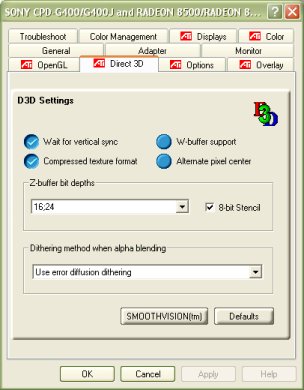
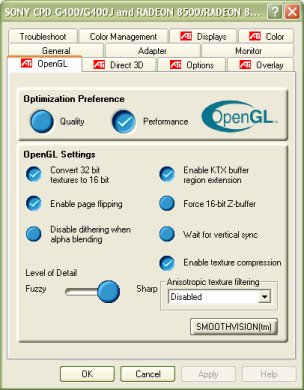
As you can see, the driver provides adjustment for the common adjustments
for Direct3D and OpenGL such as level of detail and vsync.
So after the initial installation hiccups, everything has been extremely
smooth. I haven't experienced a single driver crash throughout testing.
Card Features
Before we move onto performance, I'll quickly go over some of the features
of the card and how they performed in real world terms. First of all,
HydraVision. I was able to use my TV as a second display for watching
DVD's whilst still doing work. I was also able to hook up a 2nd monitor
via the supplied DVI-to-DSub adapter although that wasn't tested for long.
You can set the refresh rate, colour depth and resolution of the heads
independently and everything seemed to work fine. Again however, extensive
testing wasn't done on this feature.
DVD playback was fine however being a review sample, I didn't have the
full ATi CD that ships with the Radeon and so wasn't able to install ATi's
supposedly excellent DVD player software. WinDVD however worked fine and
I think it supports the hardware iDCT on the Radeon series of cards. Performance
was smooth however I can't confirm if the iDCT hardware acceleration was
actually being used.
Performance
Test System:
-
Asus P4T-E i850 Intel Pentium 4 Motherboard
-
Intel 2.0GHz Processor
-
2 x 256Mb RDRAM modules
-
Adaptec 39160 PCI SCSI Dual Channel U160 controller
-
2 x 73Gb Seagate Cheetah U160 10,000rpm SCSI disks
-
Plextor 12/10/32S SCSI CDRW
-
Creative 12x IDE DVD
We tested card performance using the 3 most common methods of determining
graphics card performance in reviewing circles, Quake 3 (v1.30), Unreal
Tournament (G.O.T.Y Edition, v436) and MadOnion's 3DMark 2001 Professional.
For benchmarking Quake3 we used Q3Bench
with the following settings.
Main tab
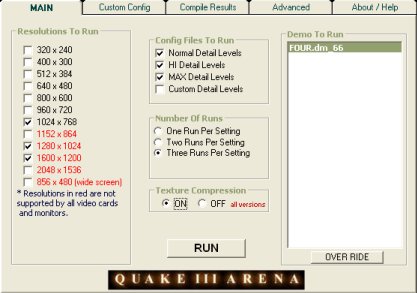
Custom config tab
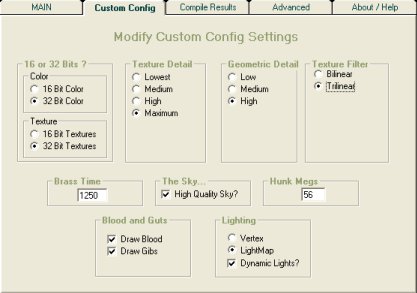
So for benching Q3 we used resolutions above 1024x768 in 32-bit colour and
32-bit textures with all quality rendering options on to really stress the
card.
For benchmarking Unreal Tournament we used the same resolutions and the
Thunder demo from Reverend.
Direct3D render options in the preferences dialog were set to defaults.
For 3DMark we did a default bench with everything as standard. No driver
tweaks were used. V-Sync was off for all 3 tests.
The 3 tests give us a broad look at the card performance using 2 DirectX
benchmarks and an OpenGL benchmark. 3DMark also tests DirectX 8 features
like pixel and vertex shaders. While no two applications are the same and
it's not wise to generalise performance using such a small cross section
of applications the 3 applications do comprise the 'standard' applications
used in most reviews so we use them.
Performance Results
Card clocks for these results were the standard, out of the box card clocks
of 275(550)Mhz memory and 275Mhz core.
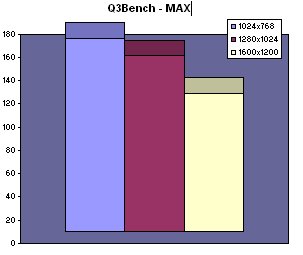
Here we can the performance of the card tail off as the resolution of the
card is pushed. The fillrate of the card is increasingly needed as we increase
resolution. Performance on the P4 is exceptional. The average framerate,
even at 1600x1200 with all options on is 122fps which make it very playable
even at such high resolution. Top marks to the card in Quake3.
Next up we have Unreal Tournament. It's the retail Game Of The Year edition
and it's version 436 out of the box so it doesn't require patching. Just
install and go. Unreal Tournament is more affected by CPU speed than graphics
card speed but you can still see the effect increasing the resolution has
on the card.

UT is CPU limited so the dropoff in framerate isn't dramatic. UT spends
a lot of time on lighting and model calculations so a fast CPU is essential
for decent UT gaming at high res. The P4 and Radeon don't disappoint.
Next up we have 3DMark 2001 Professional. This benchmark is all about the
card. Card clocks and driver tweaks have a large effect on 3DMark scores.
The following result is from the default bench, no driver tweaks and stock
card clocks.
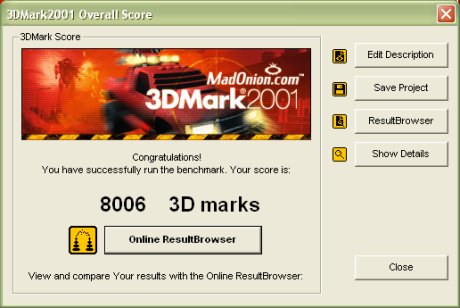
That's an impressive score given the platform and it's the highest default
bench score I've yet seen without any kind of tweaking. That's a straight
out of the box score and very impressive. It's a good 700 points clear of
a GF3 running on the same system.
We can see why NVIDIA released the Ti500 to compete with the Radeon 8500
since with the right drivers its a very impressive performer. Remember,
all these benchmarks were done on Windows XP Professional.
Overclocking
From what I've seen and read, the R8500 cards are responding well to overclocking.
While overclocking and testing on the card has been limited I was able to
push the card to 312/313 for some tests and benchmarks. The highest stable
overclock that ran all the games and test without and artifacts and without
using special cooling was 305/305. Here's a 3DMark result @ 305/305.
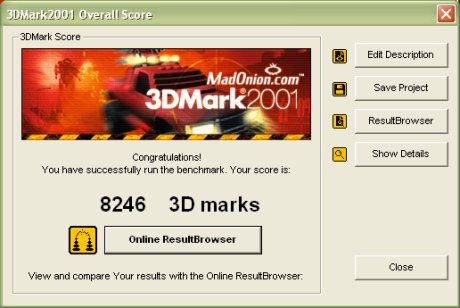
We're seeing a 3% increase in 3DMark for a 10% increase in clocks, both
core and memory. Not too shabby and of course 3DMark responds better in
some tests where the T&L unit is being exercised like Nature and the
core clock speed is important and better in other like Dragothic where memory
performance is perhaps more important.
We see similar 2 to 5% increases in Quake3 by upping the clocks to 305/305
so increased performance is quite consistent. I feel the Radeon responds
well to overclocking, just like the GeForce3 series it competes against.
Conclusion
I'd love to give the Radeon an Editors Choice Award I really would. I love
the hardware, it's a nice design, support for DX8.1 is good etc. But the
drivers aren't what I'd call production usable. For instance, during the
writing of the last half of this review, following a reboot to install UniTuner,
I'm suddenly left with only 60Hz as a refresh rate.
While I can apparently set other refresh rates with success, with both the
windows display control panel, Powerstrip and UniTuner all reporting success
in setting different refresh rates, my eyes and monitor both tell me otherwise.
Accessing the OSD for my Sony G400 tell me that 60Hz is what's being used
to drive it, despite various software supposedly setting other refresh rates.
I can only conclude this is a driver issue. Reinstalling the driver hasn't
helped and I shouldn't have to delve into the registry manually to fix things.
Refresh rate switching is a standard driver function and should just work,
no questions.
However, with the new drivers the card performs very well. I played Quake3,
UT, Colin McRae 2, Serious Sam, Max Payne and also some Championship Manager
00/01 during the course of having the card and also a very brief shot of
Half Life: Opposing Force, all without any problems, performance issues
or serious rendering issues. In that respect, I award the card points.
Hopefully the drivers continue to get better as time goes on, it's just
unfortunate they weren't better than this out of the box. For those willing
to persevere however, not that you should have to, it's a fine card, very
good performer and recommended if you like your image quality sharp and
your DVD playback smooth.
Just short of an Editors Choice Award on account of the driver issues and
problems installing and testing the card. Finally, while I would have liked
to have gone over SMOOTHVISION in more detail we just didn't have time.
I'm happy to direct you to this article at AnandTech
that goes into excellent detail on SMOOTVISION and AA in general. While
not in house Hexus material, it's an excellent read and we're happy to recommend
it!
|





















